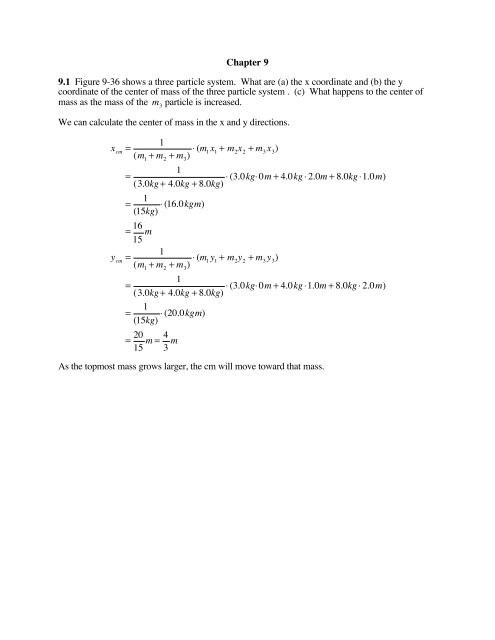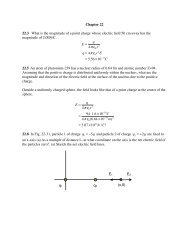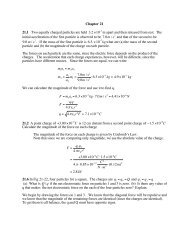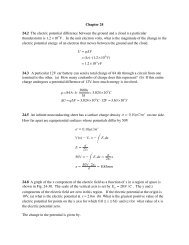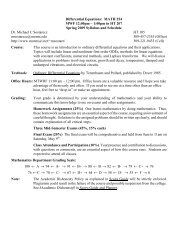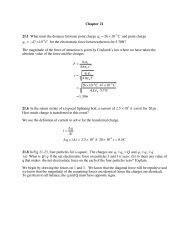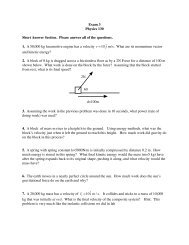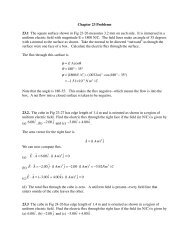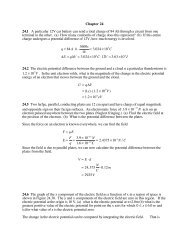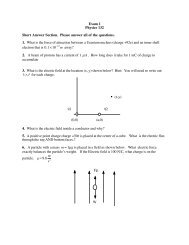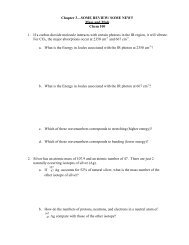Chapter 9 05
Chapter 9 05
Chapter 9 05
Create successful ePaper yourself
Turn your PDF publications into a flip-book with our unique Google optimized e-Paper software.
<strong>Chapter</strong> 9<br />
9.1 Figure 9-36 shows a three particle system. What are (a) the x coordinate and (b) the y<br />
coordinate of the center of mass of the three particle system . (c) What happens to the center of<br />
mass as the mass of the m 3<br />
particle is increased.<br />
We can calculate the center of mass in the x and y directions.<br />
x cm<br />
=<br />
=<br />
=<br />
1<br />
(m 1<br />
+ m 2<br />
+ m 3<br />
) ⋅ (m 1 x 1 + m 2 x 2 + m 3 x 3 )<br />
1<br />
⋅ (3.0kg⋅ 0m + 4.0kg ⋅ 2.0m + 8.0kg ⋅1.0m)<br />
(3.0kg + 4.0kg + 8.0kg)<br />
1<br />
(15kg) ⋅ (16.0kgm)<br />
= 16<br />
15 m<br />
1<br />
y cm<br />
=<br />
(m 1<br />
+ m 2<br />
+ m 3<br />
) ⋅ (m y + m y + m y )<br />
1 1 2 2 3 3<br />
1<br />
=<br />
⋅ (3.0kg⋅ 0m + 4.0kg ⋅1.0m + 8.0kg ⋅ 2.0m)<br />
(3.0kg + 4.0kg + 8.0kg)<br />
1<br />
=<br />
(15kg) ⋅ (20.0kgm)<br />
= 20<br />
15 m = 4 3 m<br />
As the topmost mass grows larger, the cm will move toward that mass.
9.5 In the ammonia (NH3) molecule of Fig 9-39, three hydrogen atoms form an equilateral<br />
triangle, with the center of the triangle at a distance d = 9.40 ×10 −11 m from each hydrogen atom.<br />
The nitrogen atom (N) is at the apex of a pyramid, with the three hydrogen atoms forming the base.<br />
The nitrogen to hydrogen atomic ratio is 13.9 and the nitrogen to hydrogen distance is<br />
L = 10.14 × 10 −11 m . What are (a) x and (b) y coordinates of the molecules center of mass.<br />
(a). By symmetry, we can see that the x coordinate of the center of mass is 0.<br />
(b) To find the y component, we replace the 3 H atoms, with one particle with the mass of the<br />
three H atoms at the cm of the three H. The cm of the 3H is at (0,0) by symmetry.<br />
We now find the y CM by for the N and the 3H particle<br />
y N<br />
= L 2 − d 2 = (10.14 ×10 −11 ) 2 − (9.4 × 10 −11 ) 2 = 3.803 ×10 −11 m<br />
y 3H<br />
= 0.0m<br />
m N<br />
= 13.9m H<br />
y = 3m H ⋅ y 3H + m N ⋅ y N<br />
3m H<br />
+ m N<br />
= 3m H ⋅0 +13.9m H ⋅ 3.803× 10−11 m<br />
3m H<br />
+13.9m H<br />
= 3.128 × 10 −11 m<br />
= 13.9 ⋅ 3.803 ×10 −11 m<br />
3 + 13.9<br />
9.10 Two skaters , one with mass 65 kg and the other with mass 40 kg stand on an ice rink hold a<br />
ole with a length of 10m and negligible mass. Starting from the ends of the pole, the skaters pull<br />
themselves along the pole until they meet. How far will the 40 kg skater move?<br />
Assume that the 65 kg is at 10 and the 40 kg is at 0m. The cm does not move, so both skaters end<br />
up at the cm. The 40 kg skater moves from 0 to the cm.<br />
x cm<br />
=<br />
40 ⋅ 0 + 65⋅10<br />
1<strong>05</strong><br />
= 6.19m<br />
The 40 kg skater moves 6.19 m.
9.15 A shell is fired from a gun with a muzzle velocity of 20m/s at an angle of 60˚. At the top of<br />
the trajectory, the shell explodes into two equal mass fragments. One fragment, whose speed<br />
immediately after the explosion is zero falls vertically. How far from the gun does the other<br />
fragment land, assuming that the terrain is level and that the air drag is negligible.<br />
Let’s sketch what happens first<br />
Examine how long it took to reach the explosion point.<br />
v fy<br />
= 0<br />
v iy<br />
= 20m / s⋅ sin60 =17.32m / s<br />
v ix<br />
= 20m / s⋅ cos60 =10m / s<br />
a = −g<br />
v fy<br />
= v iy<br />
− gt<br />
t = v iy<br />
g =1.767s<br />
Next we find the distance traveled before the explosion.<br />
x L<br />
= v ix<br />
t =17.67m<br />
The “left” half-shell lands at x L<br />
= 17.67m. If the shell had not exploded, we know that it would<br />
land at x cm<br />
= 2⋅17.67m = 35.34m Since the forces involved in the explosion were entirely internal,<br />
the center of mass of the two shells still lands at exactly this point. Knowing where the cm is<br />
allows us to find where the second half shell will land.
x cm<br />
=<br />
1<br />
2 m ⋅ x + 1 L<br />
2 m⋅ x R<br />
m<br />
x cm<br />
=<br />
1 2 x L + 1 2 x R<br />
x R<br />
= 2x cm<br />
− x L<br />
= 2⋅ 35.34 −17.67<br />
= 53.01m<br />
9.18 A 0.70 kg ball is moving horizontally with a speed of 5.0 m/s when it strikes a vertical wall.<br />
The ball rebounds with a speed of 2.0 m/s. What is the magnitude of the change in the linear<br />
momentum of the ball<br />
Δ p =<br />
p f<br />
− p i<br />
= 0.7kg ⋅ 5m / s− 0.7kg ⋅ (−2 m / s)<br />
= 4.9kgm / s<br />
9.26 A 1.2 kg ball drops vertically onto a floor, hitting with a speed of 25 m/s. It rebounds with an<br />
initial speed of 10 m/s. It rebounds with an initial speed of 10 m/s. (a) What impulse acts on the<br />
ball during the contact? (b) If the ball is in contact with the floor for 0.020 s, what is the magnitude<br />
of the average force on the floor from the ball<br />
Δ p =<br />
p f<br />
− p i<br />
=1.2kg ⋅ (−25m / s) −1.2kg⋅ (10m / s)<br />
= 42kg m / s<br />
F = Δ p<br />
Δ t = 42kg m / s<br />
0.020s<br />
= 2100N<br />
9.35 A 91 kg man lying on a surface of negligible friction shoves a 68 g stone away from himself,<br />
giving it a speed of 4 m/s. What speed does he acquire as a result?<br />
This is a momentum conservation problem. The total momentum is zero (man and stone at rest at<br />
the beginning). The total momentum must remain zero. In the final state
p f<br />
= 0 = p m<br />
+ p s<br />
<br />
p m<br />
= − p s<br />
<br />
m m<br />
v m<br />
= −m s<br />
v s<br />
<br />
v m<br />
= − m s<br />
<br />
v<br />
m<br />
s<br />
m<br />
= − 0.068kg<br />
91.0kg ⋅ 4m / s<br />
= 0.002989m / s<br />
9.42 In Fig 9-57, a stationary block explodes into two pieces L and R that slide across a<br />
frictionless floor and then into regions with friction where they stop. Piece L, with a mass of 2.0<br />
kg, encounters a coefficient of kinetic friction µ L<br />
= 0.40 and slides to a stop in a distance<br />
d L<br />
= 0.15m . Piece R encounters a coefficient of kinetic friction µ R<br />
= 0.50and slides to a stop in<br />
distance d R<br />
= 0.25m What was the mass of the block?<br />
Since we know the mass of the L block, we’ll begin with it. The L block stops because friction<br />
does work on it. We can compute the work done<br />
W L<br />
= −F f<br />
d L<br />
= −µ L<br />
N L<br />
d L<br />
= −µ L<br />
m L<br />
gd L<br />
= −0.40⋅ 2kg ⋅9.8m / s 2 ⋅ 0.15m<br />
= −1.176J<br />
Now that we know the work done, we can compute the velocity it had after the explosion. This was<br />
the velocity it had when it hit the friction<br />
K f<br />
− K i<br />
= W = −1.176J<br />
0 − 1 2 m L v L 2 =W<br />
v L<br />
= − 2W 2⋅ (−1.176J)<br />
= −<br />
m L<br />
2kg<br />
=1.08m / s<br />
Now lets consider the right side. As before, we can compute the velocity from the work done.
K f<br />
−K i<br />
=W<br />
0 − 1 2 m R v R 2 =W<br />
− 1 2 m v 2 R R<br />
= −µ R<br />
m R<br />
gd R<br />
v R<br />
= 2µ R<br />
g d R<br />
=1.565m / s<br />
Now we know the velocities. Given that the momenta of the right and left pieces must be equal in<br />
magnitude, we can solve for the unknown mass.<br />
m L<br />
v L<br />
= m R<br />
v R<br />
m R<br />
= v L<br />
v R<br />
m L<br />
m R<br />
=<br />
1.08m / s<br />
1.565m / s ⋅ 2kg<br />
=1.38kg<br />
9.45 A 5.20 g bullet moving at 672 m/s strikes a 700 g wooden block at rest on a frictionless<br />
surface. The bullet emerges traveling in the same direction with its speed reduced to 428 m/s. (a)<br />
What is the resulting speed of the block? (b) What is the speed of the bullet-block center of mass?<br />
This is a conservation of momentum problem.<br />
<br />
p i<br />
= m b<br />
v b<br />
+ M B<br />
v B<br />
<br />
p i<br />
= 5.2 ×10 −3 kg ⋅ 672m / s + 0.7kg ⋅ 0m / s<br />
= 3.4944 kgm / s<br />
<br />
p f<br />
=<br />
p i<br />
<br />
p f<br />
= m bv b ′ + M Bv ′ B<br />
5.2 ×10 −3 kg ⋅ 428m / s + 0.7kg ⋅ ′ v B<br />
= 3.4944 kg m / s<br />
= m b<br />
′ v b<br />
+ M B<br />
′ v B<br />
= 5.2 ×10 −3 kg ⋅ 428m / s + 0.7kg ⋅ ′ v B<br />
<br />
v ′ B<br />
=<br />
3.4944 kg m / s− 5.2 ×10−3 kg ⋅ 428m / s<br />
0.7kg<br />
=1.812m / s<br />
We can find the CM velocity because it remains unchanged (since the forces are all internal to the<br />
bullet-block system)<br />
<br />
v cm<br />
=<br />
m <br />
bv b<br />
+ M B<br />
v B<br />
=<br />
m b<br />
+ M B<br />
3.4944kg m / s<br />
5.2 ×10 −3 kg + 0.7kg = 4.955m / s<br />
9.46 A bullet of mass 10 g strikes a ballistic pendulum of mass 2.0 kg. The center of mass of the<br />
pendulum rises a vertical distance of 12 cm. Assuming that the bullet remains embedded in the<br />
pendulum, calculate the bullet’s initial speed.
This is both a momentum conservation problem and an energy conservation problem. The energy<br />
conservation part is the motion of the pendulum. The total energy of the pendulum at the top of the<br />
swing is equal to the total energy of the pendulum after it has been struck by a bullet.<br />
E f<br />
= (M + m)g y<br />
E i<br />
= 1 2<br />
(M + m)v<br />
2<br />
E i<br />
= E f<br />
1<br />
2 (M + m)v 2 = (M + m)g y<br />
v =<br />
2g y<br />
= 2⋅ 9.8 ⋅ 0.12<br />
=1.534 m / s<br />
Now that we know the velocity of the bullet-pendulum immediately after the bullet strikes the<br />
pendulum, we can use momentum conservation to find the bullet’s velocity<br />
<br />
p i<br />
= p f<br />
mv b<br />
= (M + m)v<br />
(M + m)<br />
v b<br />
= v<br />
m<br />
(2.0kg + 0.01kg)<br />
= ⋅1.534m / s<br />
0.01kg<br />
= 308.3m / s<br />
9.50 In Fig. 9-60, a 10 g bullet moving directly upward at 1000m/s strikes nd passes through the<br />
center of mass of a 5.00 kg block initially at res. The bullet emerges from he block moving directly<br />
upward at 400 m/s. Tow what maximum height does the block then rise above its initial position.<br />
As in the ballistic pendulum case, this problem uses both momentum conservation and energy<br />
conservation. We begin with momentum conservation in the collision.<br />
<br />
p i<br />
= m b<br />
v b<br />
+ M B<br />
v B<br />
<br />
p i<br />
=10.0 ×10 −3 kg ⋅1000m / s + 5.0 kg⋅ 0m / s<br />
=10 kgm / s<br />
<br />
p f<br />
=<br />
p i<br />
10 ×10 −3 kg ⋅ 400m / s + 2.0kg ⋅ v ′ B<br />
=10.0 kg m / s<br />
<br />
p f<br />
= m bv b ′ + M Bv ′ B<br />
= m b<br />
′ v b<br />
+ M B<br />
′ v B<br />
=10 ×10 −3 kg ⋅ 400m / s + 2.0 kg⋅ ′ v B<br />
v ′ B<br />
= 10.0 kg m / s−10.0 ×10−3 kg ⋅ 400m / s<br />
2.0kg<br />
= 3m / s
Now we know the velocity of the block after the collision. We can use conservation of energy to<br />
find the maximum height.<br />
1<br />
2 Mv2 = Mgh<br />
h = v 2 (3m / s)2<br />
=<br />
2g 2 ⋅ 9.8m / s 2<br />
= 0.459m<br />
9.60 A steel ball of mass 0.5 kg is fastened to a cord that is 70 cm long an fixed at the far end. The<br />
ball is then released when the cord is horizontal (Fig. 9-65). At the bottom of its path, the ball<br />
strikes a 2.5 kg steel block initially at rest on a frictionless surface. The collision is elastic. Find<br />
(a) the speed of the ball and (b) the speed of the block, both just after the collision.<br />
We begin by finding the initial velocity of the ball using energy conservation.<br />
1<br />
2 mv 2 = mgh<br />
v 2 = 2gh<br />
v b<br />
= 2gh = 2 ⋅ 9.8⋅ 0.7m<br />
= 3.7m / s<br />
Now consider the collision. Both momentum and energy are conserved in this elastic collision.<br />
mv b<br />
= m v ′ b<br />
+ M v ′ B<br />
1<br />
2 mv 2 b<br />
= 1 2 m v ′<br />
2 b<br />
+ 1 2 M v ′<br />
2<br />
B<br />
We have two equations and two unknowns. We solve the momentum equation for one of the<br />
unknowns and then plug into the energy equation.
m v ′ b<br />
= mv b<br />
− M v ′ B<br />
v ′ b<br />
= v b<br />
− M v<br />
m ′ B<br />
1<br />
2 mv 2 b<br />
= 1 2 m v ′<br />
2 b<br />
+ 1 2 M v ′<br />
2<br />
B<br />
1<br />
2 mv 2 b<br />
= 1 2 m(v − M b<br />
m v ′ B )2 + 1 2 M v ′ B<br />
1<br />
2 mv 2 b<br />
= 1 2 mv 2 b<br />
+ 1 2<br />
M 2<br />
m v ′<br />
2 B<br />
− Mv b<br />
′<br />
0 = M 2<br />
v<br />
m ′<br />
2 2<br />
B<br />
− 2Mv b<br />
v ′ B<br />
+ M v ′ B<br />
0 = M m v ′<br />
2 2<br />
B<br />
− 2v b<br />
v ′ B<br />
+ v ′ B<br />
⎛ ⎛ M<br />
= v ′ B ⎜<br />
⎝ m +1 ⎞ ⎞<br />
⎜ ⎟ v ′<br />
⎠<br />
B<br />
− 2v b ⎟<br />
⎝<br />
⎠<br />
⎛ ⎛ M<br />
0 = ⎜<br />
⎝ m +1 ⎞ ⎞<br />
⎜ ⎟ v ′<br />
⎠<br />
B<br />
− 2v b ⎟<br />
⎝<br />
⎠<br />
2v<br />
v ′ B<br />
= b<br />
2⋅ 3.7m / s<br />
=<br />
⎛ M<br />
⎜<br />
⎝ m +1 ⎞ ⎛ 2.5kg<br />
⎟<br />
⎠<br />
⎜<br />
⎝ 0.5kg +1<br />
⎞<br />
⎟<br />
⎠<br />
=1.23m / s<br />
2<br />
v B<br />
+ 1 2 M ′<br />
Notice that if the mass of the ball and the mass of the block are the same, the ball will stop and the<br />
block will take all of the velocity of the ball. This is exactly what we saw in the elastic equal mass<br />
collision in lab. We finally find the ball’s velocity after the collision, by substituting back in.<br />
v ′ b<br />
= v b<br />
− M v<br />
m ′ B<br />
= 3.7m / s − 2.5<br />
0.5 ⋅1.23m / s<br />
= −2.45m / s<br />
v 2<br />
B


